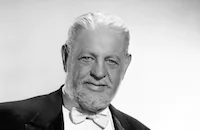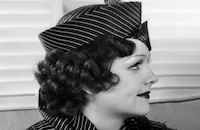Hooray for Love

Brief Synopsis
Cast & Crew
Walter Lang
Ann Sothern
Gene Raymond
Bill Robinson
Maria Gambarelli
Thurston Hall
Film Details
Technical Specs

Synopsis
Just out of college, aspiring Broadway man Doug Tyler makes the rounds of theatrical producers, but can only find work as a tour guide in a New York radio station. When his favorite singer, Pat Thatcher, performs at the station, the lovestruck Doug disrupts the show and is fired. On his way out, he runs into Commodore Jason Thatcher, Pat's conman father and would-be theatrical backer, who eventually convinces him to invest his limited inheritance in Hooray for Love , a musical revue featuring Pat. Shortly before the show's opening, however, the producers are arrested as swindlers, and with no more money, Doug is forced to stop rehearsals. Chagrined, the commodore convinces "The Duchess," the wealthy Mrs. Magenta P. Schultz, to write him a check for $15,000 in exchange for a marriage ceremony at sea. With the money in hand, the commodore slips away from the ship and returns to New York, where rehearsals continue under Doug's direction. On opening night, the costume and set suppliers, having discovered that an angry Mrs. Schultz stopped payment on the check, demand Doug's arrest, and once again, the show appears doomed. Pat, now in love with Doug, talks the suppliers into taking a chance on the show's success, while her unsuspecting father, desperate with guilt, proceeds with the marriage to The Duchess. The show goes on, and, as Pat sings "I'm Falling in Love All Over Again," Doug proposes from the wings.

Director

Walter Lang
Cast

Ann Sothern

Gene Raymond

Bill Robinson
Maria Gambarelli

Thurston Hall

Pert Kelton
Georgia Caine

Lionel Stander

Etienne Girardot

Fats Waller
Jeni Legon

Sam Hardy
Harry Kernell

Eddie Kane
Brady Cline
Perry Ivins
The Cabin Kids
Crew
Jimmy Anderson
Lucien Andriot
Vera Caspary
Alberto Colombo
George Crone
Marion Dix
Perry Ferguson
Dorothy Fields
Ray Harris
Lawrence Hazard
Jerry Hutchison
Marc Lachmann
Sammy Lee
George Marsh
Jimmy Mchugh
Walter Plunkett
Van Nest Polglase
Bradford Ropes
Paul F. Wiser
Felix Young

Film Details
Technical Specs

Articles
Hooray for Love
"Living in a Great Big Way" is just one of the musical numbers in the show-within-a-show structure of Hooray for Love, directed by Walter Lang. Sothern plays a nightclub singer who's unimpressed by the college boy, Raymond, who has a crush on her. His hope is to put on a big Broadway show after he graduates, but nothing goes as he'd hoped. Then he meets a slick operator known as "the Commodore" (Thurston Hall), who hooks him up with a duo of producers who aren't all that they seem. The Commodore also happens to be Sothern's father. Sothern is happy enough to be in the show, but wants little to do with Raymond - until, of course, he wins her over with his peculiar brand of trying-too-hard charm, which actually is surprisingly endearing.
Raymond had been performing for years by the time he was cast in Hooray for Love: He'd attended the Professional Children's School in New York City, and had made his Broadway debut at age 17. In 1931, he made his first Hollywood film, Personal Maid, later earning leading roles in films like Rowland V. Lee's charming Zoo in Budapest (1933). (Raymond was the husband of Jeanette MacDonald; the two were married from 1937 until her death in 1965.) In 1935, Sothern, a saucy blonde with a wry demeanor and a knack for comedy, was still a relative newcomer, having played a number of uncredited roles throughout the early 1930s. She was signed by Columbia pictures in 1933, only to be dropped in 1936, at which time she moved to RKO. (In 1939, she would move to MGM, playing the title role in the comedy Maisie, the first film of what would become a popular series stretching well into the 1940s.)
Raymond and Sothern proved to have a spark of on-screen chemistry and went on to make several other films together, including Walking on Air and Smartest Girl in Town (both 1936) and There Goes My Girl and She's Got Everything (both 1937). In Hooray for Love, their numbers together - particularly the finale, "I'm in Love All Over Again" - are appealing in a low-key way. But nothing else in Hooray for Love quite compares to the casually magnificent "Living in a Great Big Way," which marked the first Hollywood appearance of both the always-wonderful Waller and the lesser-known, but marvelous, Le Gon. (Robinson had appeared earlier that year with Shirley Temple in The Little Colonel.) Le Gon is terrific in "Living in a Great Big Way," a charismatic performer who preferred to perform in pants - in this number, she's dressed in lanky trousers and simple white polo neck. Le Gon had a long career as a dancer, singer, and actress, and taught dance until the end of her life: She died in 2012 at age 96. In Le Gon's New York Times obituary, Bruce Weber lauded her as "the rare female tapper who distinguished herself as a solo performer in the first half of the 20th century" and noted that, partly as a result of her preference for pants over skirts, she "developed an athletic, acrobatic style, employing mule kicks and flying splits, more in the manner of the male dancers of the time." Le Gon herself said, in an interview with The Globe and Mail of Toronto in 2009, "I could do the girls' splits, but I used the boys' splits because you could get up faster." That agility is all on display in "Living in a Great Big Way," one of the treasures of African-American performance in Hollywood, nestled in a movie where you wouldn't think to look for it.
By Stephanie Zacharek
SOURCES:
The New York Times
IMDb

Hooray for Love
TCM Remembers - Ann Sothern
TCM Remembers - Ann Sothern
Quotes
Oh, I hate the country. I'm afraid of the wildflowers.- Pat
Trivia
Notes
Marc Lachmann's unpublished story was called "The Show Must Go On." According to a Hollywood Reporter news item, Fred Keating dropped out of this production because of a scheduling conflict. Although Motion Picture Herald states that Thurston Hall was a stage and radio veteran who was making his screen debut in this production, his movie acting career actually dates back to the early silent films. Maria Gambarelli was a noted ballerina of the 1930s. According to a Hollywood Reporter news item, a nightclub sequence was shot at Prudential Studios because of overcrowding at RKO.














